
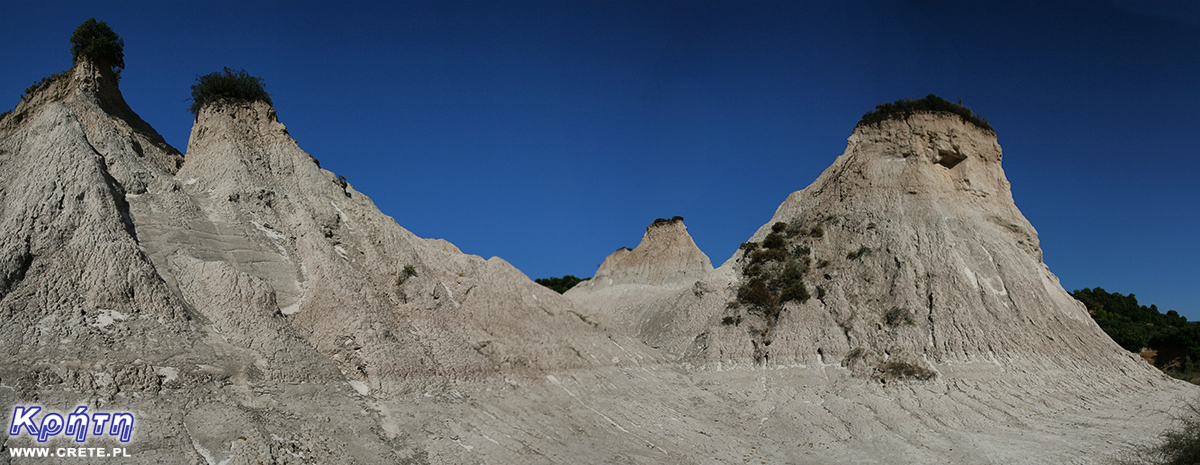
The fact that Crete can surprise you have had the opportunity to see many times. Another proof for this claim is in the village of Potamida. On the edge of this settlement grows a complex of clay mounds called Komolithi (Komolithoi). These earth pyramids, referred to as the Greek Cappadocia, form one of the strangest and most interesting landscapes in Crete.
We found information on the pyramids in the village of Potamida on the internet in 2009, when we were preparing for our next trip to Crete. We quickly joined this place to one of the routes we intended to cross. Needless to say, we have obviously achieved this goal. After this trip about the Potamid, we mentioned in our second subjective guide. We decided, however, that this place should also be included in our map of attractions in Crete. The more so because we have not found any mention of it in any Crete guide we know about. The information about the pyramids in Potamida came from several Greek publications and the portal https://www.geocaching.com/play .
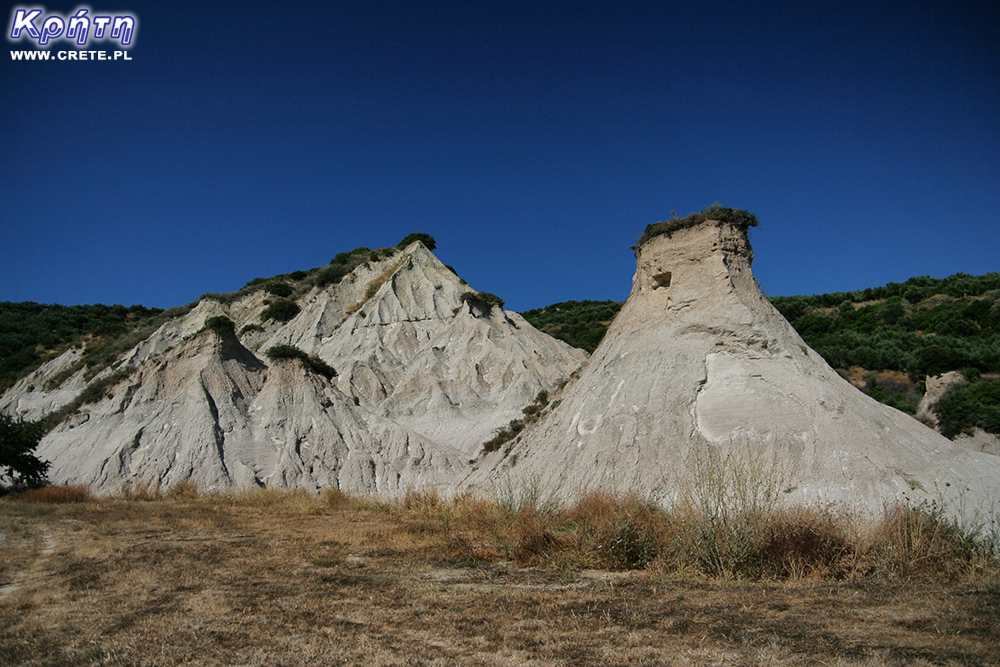
The small and not very large village of Potamida is located in the Kissamos district about 35 km west of Chania. Only a few kilometers separate it from the spectacular Gorge Topolia. To get to Komolithi, you have to cross the Potamida towards the north, turn right and continue heading north. After driving a few hundred meters, you should already notice the pyramids, which are visible on the right. When you get to the fork of roads, turn right to the side road and later you just need to look for entry to the dirt road, which you will reach to the foot of this geological phenomenon.
The pyramids are very close to the village buildings, near the Tyflos River, dry in the summer. They unexpectedly grow in the middle of a fertile field, which makes the landscape they create unique. His surrealism was appreciated by NASA, which in July 2016 published a photo of the Cretan cones as Earth Science Picture of the Day (EPOD): http://epod.usra.edu/blog/2016/06/eroded-hills-of-komolithi- crete.html
If you are there in the summer, you can safely climb the less steep cones that are dry during this period. In spring and autumn, attempting to approach them means wading the ankles in a waterlogged clay.
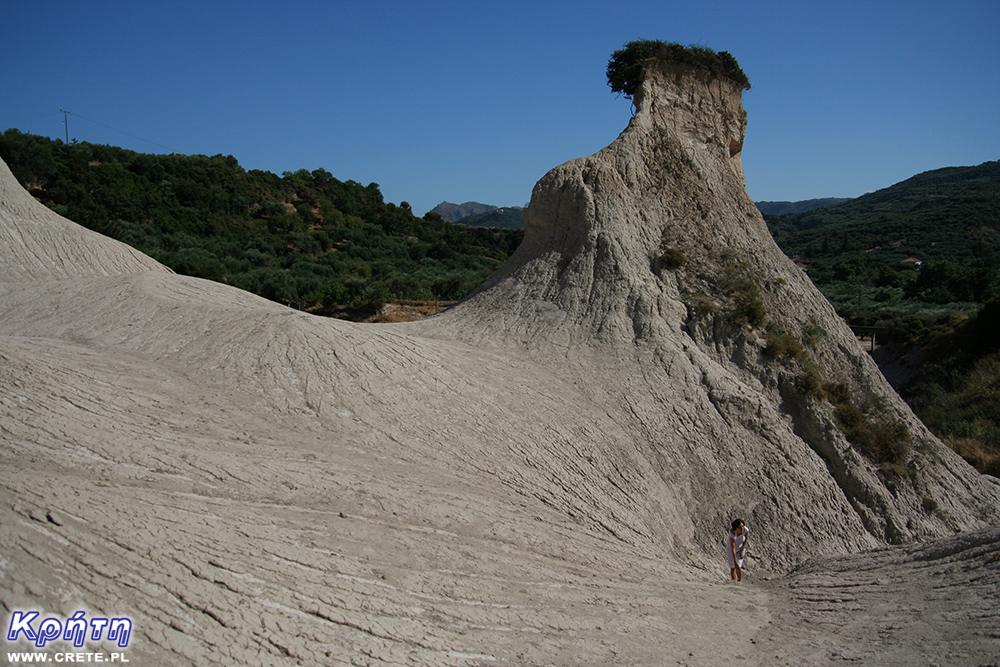
The pyramid slopes are mostly barren and only the upper part is covered with vegetation. They are almost completely made of clay. Years of erosion caused by water and wind formed this material in such unusual shapes. Researchers from the University of Crete, who recently took a closer look at this place, also found traces of pyrite called "gold of fools" and gold.
However, research into the pyramids by the Dutch in the 1970s shed more light on the mysterious pyramids. They were an attempt to determine the time of creation of these geological formations and to explain the presence of marine fossils in them, including the remains of 15-meter sharks from 7 million years ago.
To understand the genesis of this geological phenomenon, it is necessary to go back 10 million years. In Miocene (the oldest epoch of the neogen), when the Mediterranean Sea was formed, Crete was part of the archipelago. Its eastern part rose above the water, while the western one, in which Komolothoi are located, was under water. This explains the presence of marine fossils and the type of geological material from which the pyramids are built.
The first study of material from Komolothi showed that these are sedimentary rocks accumulated over 7 million years ago at the turn of the ages of torton and messyn. The original assumptions about their composition, which initially were assumed to be calcareous, were overturned. However, subsequent analyzes have shown that it is cemented with coarse dust and silicon-aluminum sludge (so-called mudstone). This silt is additionally characterized by an increased ability to bind to water molecules. Subjected to pressureit is compressed and dried in appearance resembles hardened and cracked clay.
These conclusions explain in part why before the cement entered the modern building for good, the inhabitants of the surrounding villages extracted this material from the pyramids and used it to seal the roofs of their houses.
If you were interested in photos and this description and you would like to see Komolithi with your own eyes, we suggest that you can take a look here during the return trip from Elafonissi beach. For this purpose, take the way back through the Topolia gorge. For our part, we will add that passing this way again in 2016, we found that the pyramids still stand here ;-)
↤ click the appropriate part of the island to change the bottom map
W 2002 roku Falasarna zdobyła tytuł najlepszej plaży w Grecji. Wyróżnienie to nie jest bynajmniej przypadkowe, gdyż miejsce to jak na standardy Krety jest naprawdę unikalne.
Elafonisi is a small island located at the end of the southwestern edge of Crete. A characteristic feature of Elafonisi is the shallow lagoon connecting it with Crete.
Elafonisi is a small island located at the end of the southwestern edge of Crete. A characteristic feature of Elafonisi is the shallow lagoon connecting it with Crete.
This is the second largest airport (IATA code: CHQ) in Crete. In 2010, the airport in Chania served a total of over 1.65 million passengers.
Chania (Χανιά) is the second largest (after Heraklion) city of Crete. The biggest advantage of Chania is the area of the Old Town and the beautiful Venetian Harbor.
Aptera is a city whose history dates back to at least a thousand years before our era. In the peak period, about 20,000 lived in it. people, of which only 1/5 were free people.
Chania (Χανιά) is the second largest (after Heraklion) city of Crete. The biggest advantage of Chania is the area of the Old Town and the beautiful Venetian Harbor.
The genesis of the name of this poviat will not surprise anybody who will break the road from the Imbros gorge to Hora Sfakion.
Frangokastello is a small fortress that was built by the Venetians over four years from 1371. Initially, the castle was named after Saint Nikitas.
(Χρυσοσκαλίτισσα) The Church of the Blessed Virgin Mary with the Golden Step from the 17th century is the westernmost church building of this type.
(Χρυσοσκαλίτισσα) The Church of the Blessed Virgin Mary with the Golden Step from the 17th century is the westernmost church building of this type.
Omalos is a perfect starting point for exploring the Samaria Gorge. Located over 1,100 m above sea level extends over an area of 25 km2. Its size corresponds more or less to the size of the Lasithi Plateau.
Located 47 km from the city of Chania, it is the only freshwater lake in Crete. Its area is about 580 thousand. sqm. and the maximum depth is about 45 meters
Omalos is a perfect starting point for exploring the Samaria Gorge. Located over 1,100 m above sea level extends over an area of 25 km2. Its size corresponds more or less to the size of the Lasithi Plateau.
The steel crossing, which in the central part is separated from the ground by nearly 150 m, is at the leading position of the places where the longest bungee jumps are made.
Chania (Χανιά) is the second largest (after Heraklion) city of Crete. The biggest advantage of Chania is the area of the Old Town and the beautiful Venetian Harbor.
The genesis of the name of this poviat will not surprise anybody who will break the road from the Imbros gorge to Hora Sfakion. Word
This is the second largest airport (IATA code: CHQ) in Crete. In 2010, the airport in Chania served a total of over 1.65 million passengers.
Chora Sfakion is an extremely picturesque mountain village of the mountainous and wild Sfakia region
Loutro is famous for the fact that you can get to it only from the sea or walk on the mountain trail, because there is no other road here.
Stavros used to be a small fishing village. Today, it is primarily a tourist destination, but in a positive sense.
The cave is less than 1 km from Moni Gouvernetou Monastery. You will reach it using the pedestrian trail that has been marked out along the slope of the Avlaki Gorge.
Balos is one of Crete's flagship beaches if not all of Greece. We can assure you that the landscapes you see during your trip to Balos will remain with you for a very long time.
Moni Katholiko is probably the oldest and most spectacular monastery in Crete. It is located 20 km north-east of Chania.
The Orthodox monastery of Agia Triada, located on the northern part of the Akrotiri peninsula, is one of the most beautiful and richest monasteries in Crete.
The Orthodox monastery of Agia Triada, located on the northern part of the Akrotiri peninsula, is one of the most beautiful and richest monasteries in Crete.
Gouverneto Monastery is probably the oldest active Greek Catholic monastery located on the Akrotiri peninsula near Chania.
The length of the trail leading through this place is about 8 kilometers and the difference in altitude is about 600m.
Agia Roumeli znajduje się na południowym wybrzeżu Prefektury Chania, pomiędzy miejscowościami Chora Sfakion i Paleochora.
Until the early nineties, this place was known only to few tourists and local residents.
Paleochora is a quite well-organized tourist town, with a beautiful large sandy beach
Ruiny starożytnego miasta Lissos znajdują się około 3,5 km od miejscowości Sougia na południowym wybrzeżu Krety.
Samaria is one of the most important tourist attractions located in the western part of Crete.
On the north-western coast of Crete, at the foot of the Gramovous peninsula, there are ruins of the ancient port of Korikos, later known as Falassarna.
Krios Beach is located about 9 km west of Paleochora and it is also the last beach on this stretch of the southern coast
Between the villages of Topolia and Koutsamatados there is an interesting cave known as Agia Sofia
Milia is an authentic mountain settlement, which most probably dates from about the seventeenth century.
On the edge of the village of Potamida grows a complex of clay mounds called Komolithi (Komolithoi)
Grammeno (Γραμμένο) is a beach that can be counted among one of the best and most beautiful beaches in this part of Crete.
Platanias is a popular tourist destination. It is here that there are very interesting tunnels from World War II.
Polyrinia was one of the most important city-states of western Crete during the Hellenistic and Roman periods. It was built amphitheater on a steep hill, rising to a height of 481 meters above sea level
The Agia Irini gorge, just a short distance from the village of Sougia, is one of the most popular hiking destinations.
The island of Gramvousa, or in fact Imeri Gramvousa (Ήμερη Γραμβούσα), is an inseparable point of a trip that combines a stay in the Balos Lagoon with visiting the remains of a fortress located on the top of the island of Imeri Gramovousa.
Agia Roumeli is located on the south coast of Chania Prefecture, between Chora Sfakion and Paleochora.
The Byzantine church of Agios Pavlos was erected on the remote Selouda Beach in the south of Crete.
There is a beach in Crete that literally makes some people shiver. This place is Seitan Limania which can be translated as Satan's Ports or Cursed Ports.
Aspri Limni means White Lake, although the lake is just a conventional name. Under this term there is a small bay.
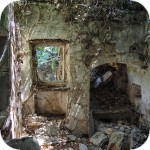
Only a few kilometers separate the bustling city of Rethymno from Mili, a village abandoned by its inhabitants. This place is also called the village hidden in the gorge. This name perfectly describes Mili because it is located on the edge of a small and green ravine of the same name. Although Mili was abandoned by its inhabitants, in recent years it has become a tourist attraction. It must be admitted that a walk between old buildings, which are slowly absorbed by the surrounding nature, gives rise to a slight thrill, and a more exuberant fantasy while looking into the nooks and crannies of old houses may suggest scenarios straight from horror movies.
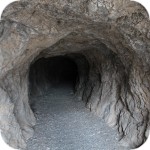
The extensive beach in Plakis invites to long walks. Particularly interesting is the eastern beach area located below the steep cliffs called Gonates. Many people who explore this part of the coastline are sure to find a mysterious tunnel in this place. The presence of this building raises many puzzles not only among tourists, but even among local residents.
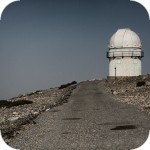
The observatory is located at the top of the Skinakas mountain at an altitude of 1750 m. The idea for its construction was born in 1984, soon after the construction of the road leading to the mountain began. It was a joint initiative of the Cretan University, the Foundation for Research and Technology - Hellas (FORTH) and the German Max-Planck-Institut für Extraterrestrische. These organizations work together to provide students with modern education in the field of astronomy, and support astronomical observations including extended sky research and objects such as comets or nebulae.


Komentarze
super miejsce:)
poprawcie sobie adres strony na www.geocaching.com
dzięki temu serwisowi mozna dotrzec do na prawdę ciekawych miejsc na świecie :):)
Ola dzięki za zwrócenie uwagi :) . Faktycznie dla skróconego adresu był przypisany zły certyfikat bezpieczeństwa i strona nie ładowała się. Teraz już powinno być ok.
Piękna grecka kapadocja
Byłem wraz z małżonką zobaczyliśmy ,zapiera dech, są to naprawdę ciekawe stożki które mało kto odwiedza polcamy.
Wypełnij poniższy formularz aby dodać komentarz
lub kliknij w poniższy link aby skorzystać z możliwosci komentowania przez facebooka:
https://www.facebook.com/crete.poland/posts/10154463884197551